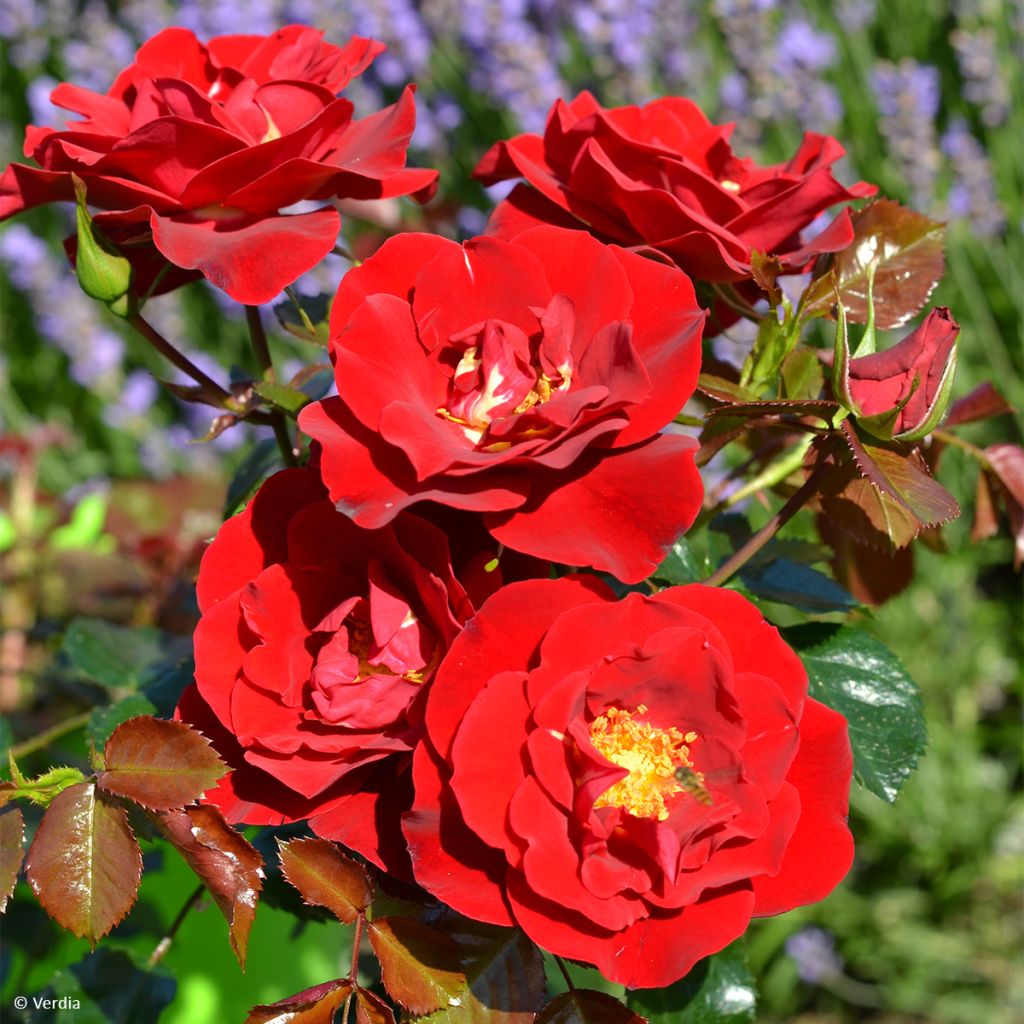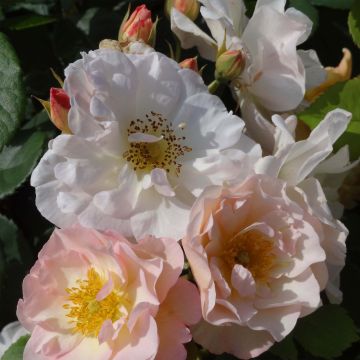

Rosier Décorosier® New Vesuvia®


Rosier Décorosier® New Vesuvia®


Rosier Décorosier® New Vesuvia®


Rosier Décorosier® New Vesuvia®
Rosa New Vesuvia - shrub rose
Rosa Décorosiers® New Vesuvia ®
Shrub rose
Opening a complaint ticket as I received the wrong reference (845801 = Red Ballerina).
Thierry, 02/06/2022
Special offer!
Receive a €20 voucher for any order over €90 (excluding delivery costs, credit notes, and plastic-free options)!
1- Add your favorite plants to your cart.
2- Once you have reached €90, confirm your order (you can even choose the delivery date!).
3- As soon as your order is shipped, you will receive an email containing your voucher code, valid for 3 months (90 days).
Your voucher is unique and can only be used once, for any order with a minimum value of €20, excluding delivery costs.
Can be combined with other current offers, non-divisible and non-refundable.
Home or relay delivery (depending on size and destination)
Schedule delivery date,
and select date in basket
We guarantee the quality of our plants for a full growing cycle, and will replace at our expense any plant that fails to recover under normal climatic and planting conditions.
Description
The Decorosier New Vesuvia Rose Bush, intended to replace the excellent variety Vesuvia, closely resembles it, but its magnificent red flowers are larger and even more vibrant. Classified in the category of shrub roses, it is an excellent rose bush capable of forming a superb ground cover due to its low, dense, and well-covering habit. It is strong and floriferous and provides an exceptional, almost permanent decoration requiring very little maintenance, and a long uninterrupted flowering from May until the first frost. It is disease-resistant and well-suited for informal mass planting in gardens, alongside simple perennials or shrubs with colourful foliage.
The 'New Vesuvia' rose is classified as a modern, groundcover shrub rose. Its clustered flowers come from the polyantha rose, an old hybrid derived from Rosa multiflora and Rosa chinensis. It is a very dense bush, 70 to 80 cm (28 to 32in) tall, forming a slightly spreading dome about 90 cm (35in) to 1 m (3ft) wide, depending on growing conditions. It is very floriferous and produces an abundance of 6-7 cm (2-3in) diameter, barely semi-double, deep red flowers from May to October with a beautiful cluster of golden yellow stamens. They have no fragrance, but they are visited by pollinating insects. The foliage of this rose is more or less evergreen in winter depending on the climate. It consists of small, shiny dark green leaves that cover its thorny stems. Its disease resistance is excellent. This variety tolerates heat well.
The New Vesuvia rose is suitable for mass plantings, flower beds, large spaces, slopes, or low hedges, in containers, etc. It adapts to all soils that are not too wet and all climates, allowing it to be grown from the north to the south. It has a well-covering growth habit that works well on a slope, where it will cover the ground. When planted en masse, it will also border pathways and highlight flower beds. For example, it can be grown with perennial geraniums (Geranium Blue Cloud, Anne Folkard, Nimbus, Orion), campanulate flowers (lactiflora, rapunculoides), catmints, lavenders, snapdragons, foxgloves, or Stachys. Left to grow freely, it will form a loosely shaped, blooming, and cloudy bush, with a very natural appearance in front of a flowering shrub border.
Report an error about the product description
Rosa New Vesuvia - shrub rose in pictures






Plant habit
Flowering
Foliage
Botanical data
Rosa
Décorosiers® New Vesuvia ®
Rosaceae
Shrub rose
Cultivar or hybrid
Planting and care
Decorosier rose bushes prefer a sunny location (at least 4 to 5 hours of sunlight per day), sheltered from strong winds. However, 'New Vesuvia' tolerates heat very well and adapts to most soils. All rose bushes like loose, permeable and humus-rich soils. They prefer slightly acidic soil but will adapt to any garden as long as the soil is well-worked and sufficiently rich. To plant your rose bush, prepare your soil to a depth of 25 cm (10in) by breaking up the soil and adding a base fertiliser such as dried blood or bonemeal. Remove your plant from its pot and position, covering the top of the root ball with 3 cm (1in) of soil, backfill and water thoroughly to eliminate air pockets. In dry weather, regular watering for a few weeks is necessary to aid root establishment. Provide your rose bush with special rose fertiliser that stimulates plant flowering.
Pruning is not essential, but you can clean up old wood and shorten some branches to 2/3 of their growth at the end of winter.
Planting period
Intended location
Care
-
, onOrder confirmed
Reply from on Promesse de fleurs
Similar products
Haven't found what you were looking for?
Hardiness is the lowest winter temperature a plant can endure without suffering serious damage or even dying. However, hardiness is affected by location (a sheltered area, such as a patio), protection (winter cover) and soil type (hardiness is improved by well-drained soil).

Photo Sharing Terms & Conditions
In order to encourage gardeners to interact and share their experiences, Promesse de fleurs offers various media enabling content to be uploaded onto its Site - in particular via the ‘Photo sharing’ module.
The User agrees to refrain from:
- Posting any content that is illegal, prejudicial, insulting, racist, inciteful to hatred, revisionist, contrary to public decency, that infringes on privacy or on the privacy rights of third parties, in particular the publicity rights of persons and goods, intellectual property rights, or the right to privacy.
- Submitting content on behalf of a third party;
- Impersonate the identity of a third party and/or publish any personal information about a third party;
In general, the User undertakes to refrain from any unethical behaviour.
All Content (in particular text, comments, files, images, photos, videos, creative works, etc.), which may be subject to property or intellectual property rights, image or other private rights, shall remain the property of the User, subject to the limited rights granted by the terms of the licence granted by Promesse de fleurs as stated below. Users are at liberty to publish or not to publish such Content on the Site, notably via the ‘Photo Sharing’ facility, and accept that this Content shall be made public and freely accessible, notably on the Internet.
Users further acknowledge, undertake to have ,and guarantee that they hold all necessary rights and permissions to publish such material on the Site, in particular with regard to the legislation in force pertaining to any privacy, property, intellectual property, image, or contractual rights, or rights of any other nature. By publishing such Content on the Site, Users acknowledge accepting full liability as publishers of the Content within the meaning of the law, and grant Promesse de fleurs, free of charge, an inclusive, worldwide licence for the said Content for the entire duration of its publication, including all reproduction, representation, up/downloading, displaying, performing, transmission, and storage rights.
Users also grant permission for their name to be linked to the Content and accept that this link may not always be made available.
By engaging in posting material, Users consent to their Content becoming automatically accessible on the Internet, in particular on other sites and/or blogs and/or web pages of the Promesse de fleurs site, including in particular social pages and the Promesse de fleurs catalogue.
Users may secure the removal of entrusted content free of charge by issuing a simple request via our contact form.
The flowering period indicated on our website applies to countries and regions located in USDA zone 8 (France, the United Kingdom, Ireland, the Netherlands, etc.)
It will vary according to where you live:
- In zones 9 to 10 (Italy, Spain, Greece, etc.), flowering will occur about 2 to 4 weeks earlier.
- In zones 6 to 7 (Germany, Poland, Slovenia, and lower mountainous regions), flowering will be delayed by 2 to 3 weeks.
- In zone 5 (Central Europe, Scandinavia), blooming will be delayed by 3 to 5 weeks.
In temperate climates, pruning of spring-flowering shrubs (forsythia, spireas, etc.) should be done just after flowering.
Pruning of summer-flowering shrubs (Indian Lilac, Perovskia, etc.) can be done in winter or spring.
In cold regions as well as with frost-sensitive plants, avoid pruning too early when severe frosts may still occur.
The planting period indicated on our website applies to countries and regions located in USDA zone 8 (France, United Kingdom, Ireland, Netherlands).
It will vary according to where you live:
- In Mediterranean zones (Marseille, Madrid, Milan, etc.), autumn and winter are the best planting periods.
- In continental zones (Strasbourg, Munich, Vienna, etc.), delay planting by 2 to 3 weeks in spring and bring it forward by 2 to 4 weeks in autumn.
- In mountainous regions (the Alps, Pyrenees, Carpathians, etc.), it is best to plant in late spring (May-June) or late summer (August-September).
The harvesting period indicated on our website applies to countries and regions in USDA zone 8 (France, England, Ireland, the Netherlands).
In colder areas (Scandinavia, Poland, Austria...) fruit and vegetable harvests are likely to be delayed by 3-4 weeks.
In warmer areas (Italy, Spain, Greece, etc.), harvesting will probably take place earlier, depending on weather conditions.
The sowing periods indicated on our website apply to countries and regions within USDA Zone 8 (France, UK, Ireland, Netherlands).
In colder areas (Scandinavia, Poland, Austria...), delay any outdoor sowing by 3-4 weeks, or sow under glass.
In warmer climes (Italy, Spain, Greece, etc.), bring outdoor sowing forward by a few weeks.








































